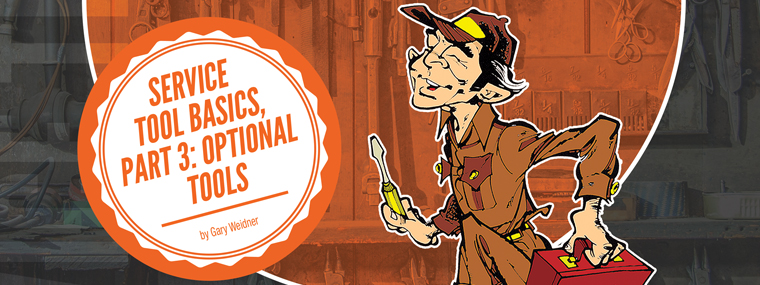
Service Tech Training: Service Tool Basics, Part 3: Optional Tools
By Gary Weidner / Published October 2015

Editor’s Note: This service technician training series was published previously from September 2008 through June 2014 in Cleaner Times| IWA. It is being republished with the recognition this material is not exhaustive of the subject at hand, but rather to present to new servicepeople an all-important fundamental understanding of how things work.
The last two columns (see July and August 2015) offered suggested lists of basic and essential tools for servicing pressure washers. Now, we’ll take a look at some optional tools, which, on the one hand, you can generally get by without; yet, on the other hand, you should have most of them if you want to be a true professional. Of course, your employer may provide some of these things, and the exact nature of your work will influence what items are important to you.
Optional Non-Tool Tools
• Pocket Magnifier—with or without light. Have you ever tried to make out numbers on the wash tip of an unfamiliar machine?
• Pocket Calculator—do you sometimes have to figure up a bill in the field? Convert inches to centimeters? A serviceperson should also know how to calculate motor horsepower needed to drive a pump, pulley ratios, corresponding flow rates, etc.
• Kitchen Baster (syringe type).
• Assorted Funnels—the cheap plastic ones are fine. Another good one to have is the long-neck “transmission” type funnel.
• Garden Hose Ball Valve—if you’re doing some work that involves turning the water on and off repeatedly, put this little valve at the end of the garden hose. Saves lots of steps.
• Rubber Boots—I keep a pair of what the contractor supply houses call “slush boots” in the service truck. They slip on right over my work shoes and come almost up to my knees.
• Creeper(s)—you may be surprised at the usefulness of a regular mechanic’s creeper. A stool-type creeper (with tool tray underneath) is also handy. The creeper I use most is a “kneel-on” type; it’s just a small, padded rectangle with four casters, available from Snap-On and others. It’s compact enough to keep in the service truck. In the field, it can keep your knees (and tools) off a wet/dirty floor.
Optional Wrenches
• Monkey Wrench—Why? Because the 90-degree head angle works in some situations where a regular adjustable wrench won’t fit. Don’t forget to get both left- and right-hand types.
• Set of T-handle Allen Wrenches, inch and metric—wonderful for hard-to-reach set screws or cap screws.
• Torque Wrench(es)—especially for pump work.
• Air Ratchet (3/8 drive)—speeds up your work in the shop.
• Set of Ratcheting Box Wrenches, inch and metric—good for situations that are too tight for ratchet drives.
• Oil Filter Wrench(es)—for small engines and some brands of water separating fuel filters. OTC tools makes a good quality “one-size-fits-all” variation: the filter strap wrench.
• Plumber’s Basin Wrench—the swiveling, toothed jaw grabs like a pipe wrench, but reaches into inaccessible areas. Some have adjustable-length handles. If you’re not already familiar with this item, check on it at plumbing tool suppliers.
• Oil Burner Nozzle Wrench (“nozzle changer”)—available from oil burner supply houses. This wrench consists of two concentric sockets, one inside the other and each with its own handle. Delavan makes a nice one for American dimension burners.
Other Optional Tools
• Five lb hammer or maul.
• Crowbar (24 inch is a good size).
• Stubby hand saw for wood, such as the Stanley “Short Cut”—You’d be surprised at the uses—cut a piece of 2 x 4 for a block; cut heavy gauge, triple-wall corrugated carton material.
• Grease gun—Be sure to get the one-hand operated type! Also buy a flexible whip hose and add it to the gun.
• Hose pinch pliers, such as KD #145—These are made to pinch shut tubing or hosing. They have a ratchet lock with thumb release. It’s a good idea to have two; for example, to pinch off both supply and return fuel lines on some oil burners. I marked one with red paint to make it easy to avoid mixing up supply and return lines. Get them at an automotive tool supplier.
• Magnetic pickup tools, larger and smaller sizes—Preferably with retractable extension handles.
• “Retractable finger” type pickup tool—With flexible shaft.
• Set of cold chisels.
• Hand reamer, such as KD #2043—Enlarge holes in sheet metal from smaller sizes up to 1/2 inch. Get it at an automotive tool supplier.
• Tubing cutter.
• Gasket scraper—Get it at an automotive tool supplier.
• Putty knife.
• Awl.
• Nut driver set, inch and metric—Or “screwdriver” handle to use with equivalent small sockets
• Torx driver set and/or socket bit set.
• Set of driver bits—For use with electric drills; Phillips, hex, etc.
• Set of number size drill bits—To check, clean, or drill gas fuel orifices.
• Gear puller—Such as OTC #1023 2 ton, 2-jaw/3-jaw convertible.
• Retaining ring pliers—Internal and external, available in several sizes and with angle heads.
• V-belt tensioner—This is a jack screw type device that works between two pulleys to tighten the belt.
• Propane torch—I like the instant-light pushbutton type.
• Electric soldering gun or iron and related supplies such as solder, flux, and emery cloth.
Note—we’ll cover items for small engine work in a later installment.



